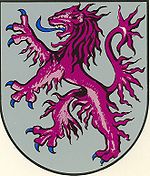Marquess of Gouveia
Appearance

Marquess of Gouveia (in Portuguese Marquês de Gouveia) was a Portuguese
title of nobility created by King Philip III of Portugal, also known as Philip IV of Spain, by a royal decree dated from January 20, 1625, granted to Manrique da Silva, who already was 6th Count of Portalegre
, second male child of the 4th Counts of Portalegre.
The title was extinguished by King Joseph I of Portugal following the Távora affair.
In the late 19th Century, King
Charles I of Portugal
granted the title of Marquis of Gouveia (as a second creation) to Afonso de Serpa Leitão Freire Pimentel, by a royal decree dated from November 15, 1900 .
List of the Marquesses of Gouveia
First creation (1625)
- Manrique da Silva, also 6th Count of Portalegre;
- João da Silva (c. 1625-1686), also 7th Count of Portalegre;
- Martinho Mascarenhas, (1681-1723), also 6th Count of Santa Cruz;
- João Mascarenhas (1699- ? ), also 7th Count of Santa Cruz;
- José Mascarenhas da Silva e Lencastre (1708-1759), also 8th Count of Santa Cruz and 8th Duke of Aveiro;
- Martinho Mascarenhas (1740-1805), older male child of the 5th Marquis of Gouveia, he was nicknamed o marquesinho (the little Marquis).
Second creation (1900)
- Afonso de Serpa Leitão Freire Pimentel (1848-1930), 1st Count of Gouveia (May 20, 1879, by King Charles I);
- Jorge de Serpa Pimentel (1923-1997), also 3rd Baron of São João de Areias;
- Jorge Paiva Brandão de Serpa Pimentel (born 1958), also 4th Baron of São João de Areias.
